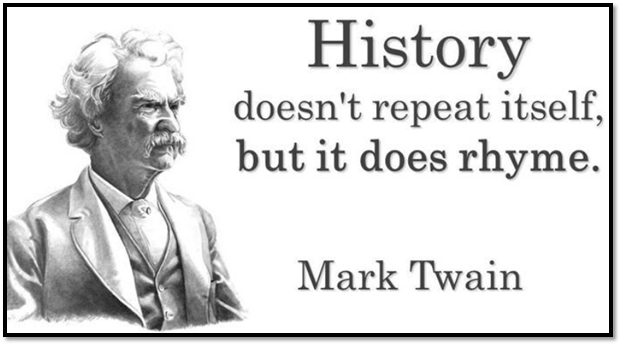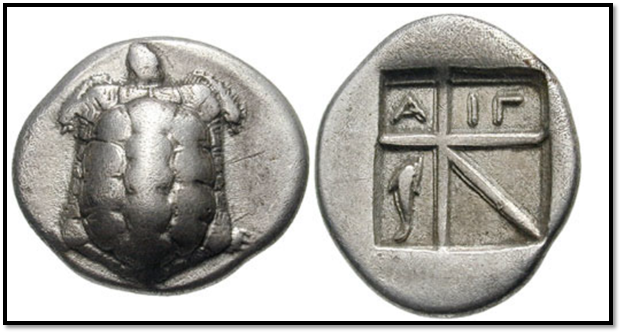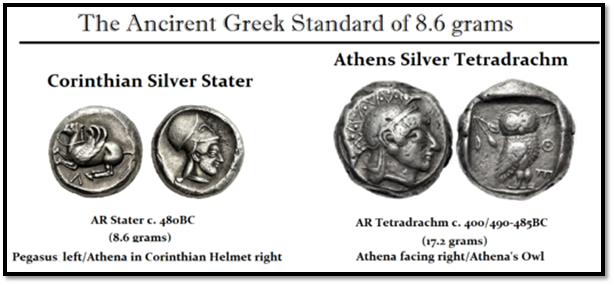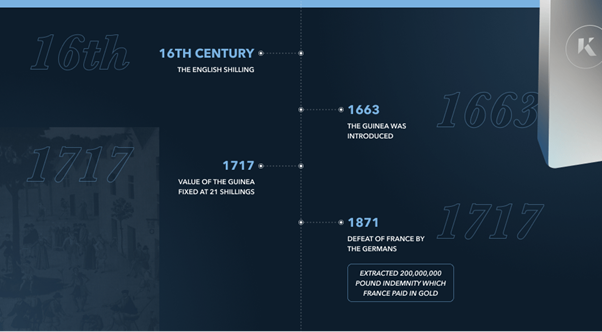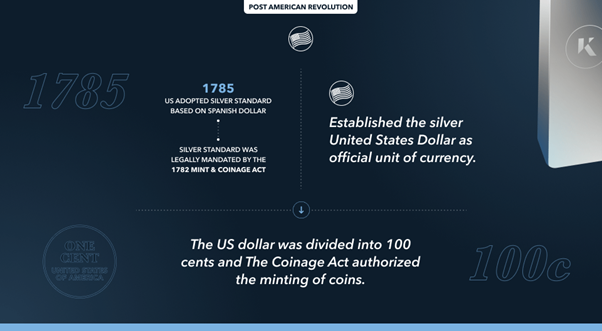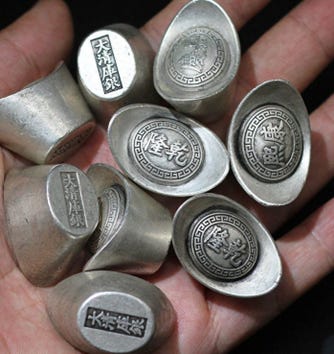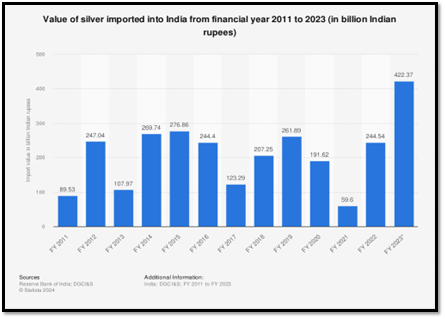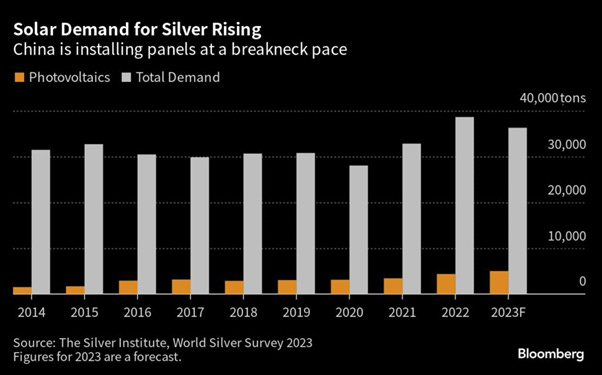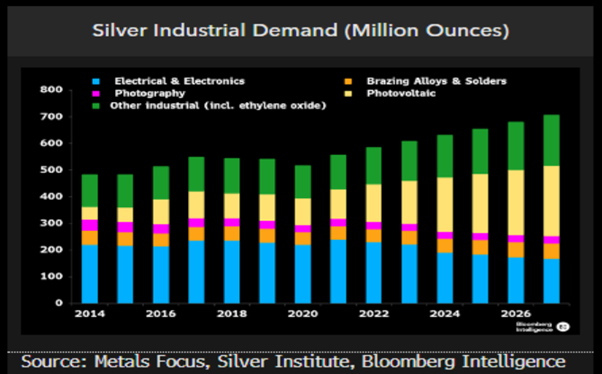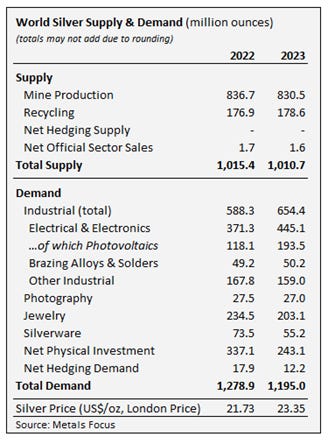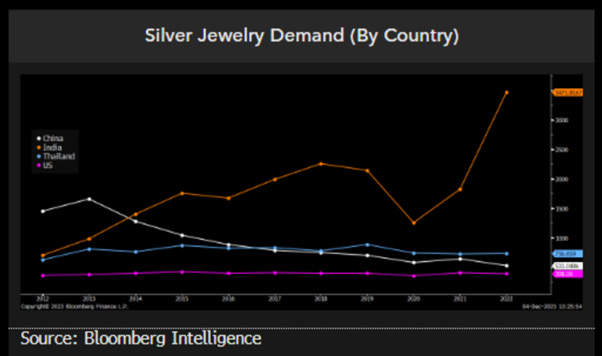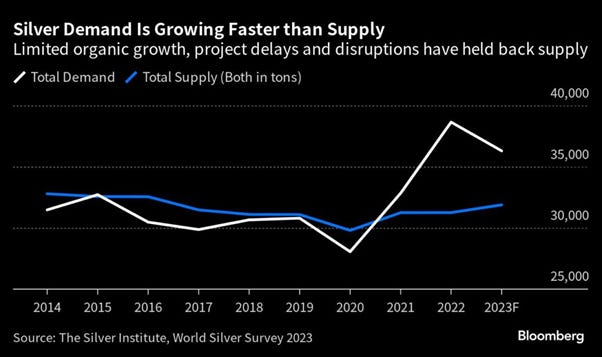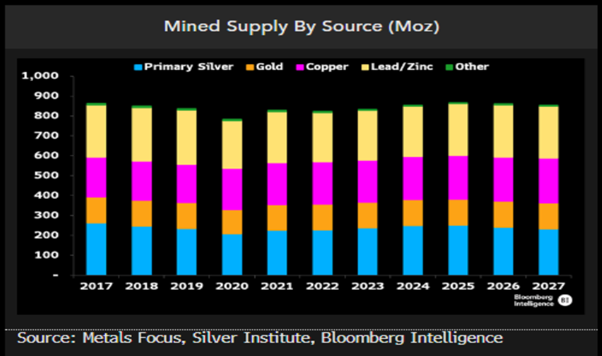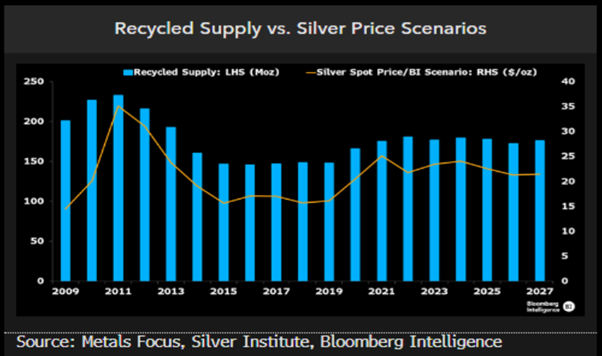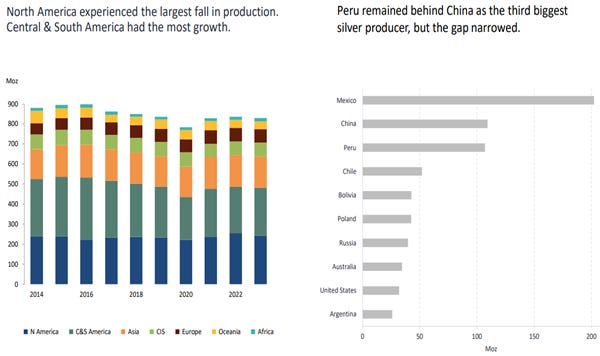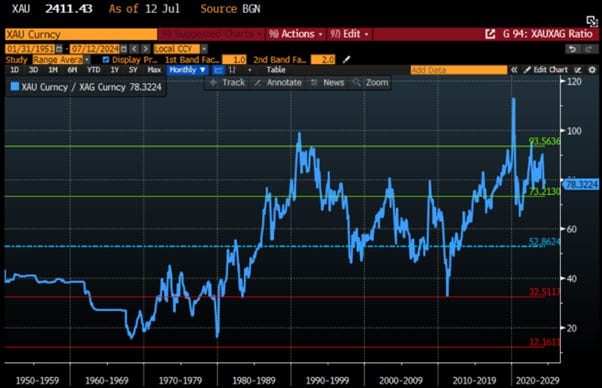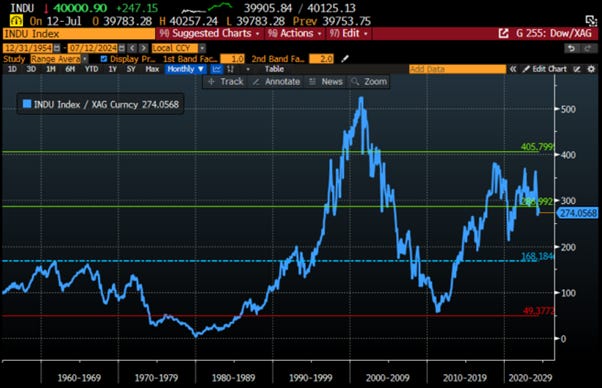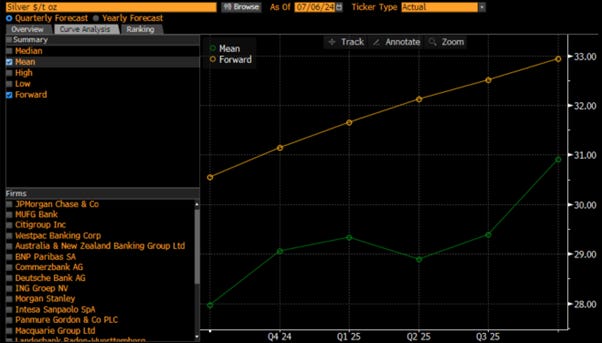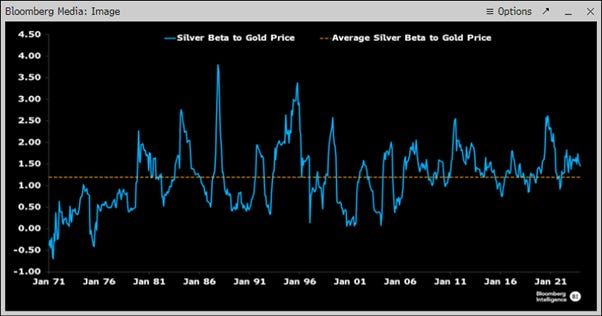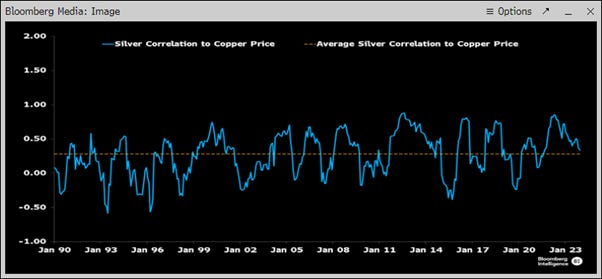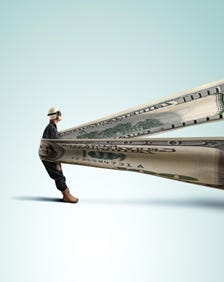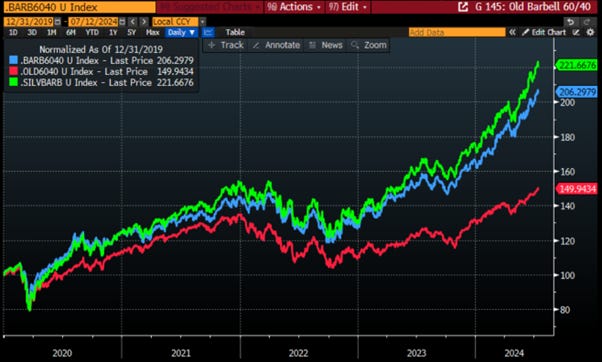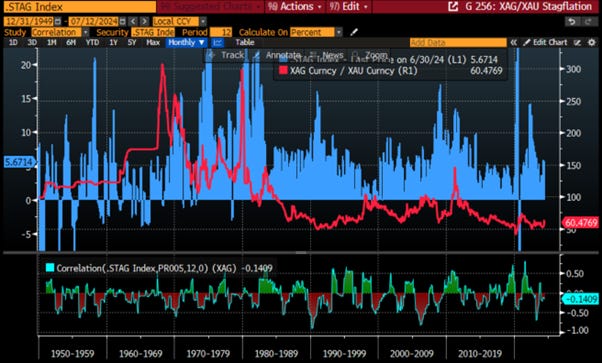Silver Linings Of Money
As the collapse of the establishment unfolds in major Western countries, it suggests that the future will markedly differ from the past decades. These mounting uncertainties are prompting investors to seek antifragile assets that cannot be unilaterally confiscated due to unpredictable government decisions, which are expected to become more avaricious and unstable. Throughout history, apart from physical gold, physical silver has stood out as a monetary silver lining. Mark Twain's famous words about history rhyming rather than repeating itself echo the common sentiment that humans often fail to learn from history. Nevertheless, delving into the annals of the past remains valuable.
Silver is a chemical element with the symbol Ag (from the Latin word 'argentum', derived from Proto-Indo-European *h₂erǵ meaning 'shiny, white') and atomic number 47. It is a soft, white, lustrous transition metal, known for exhibiting the highest electrical conductivity, thermal conductivity, and reflectivity of any metal. Silver is found in the Earth's crust in its pure, free elemental form (known as 'native silver'), as well as in alloys with gold and other metals, and in minerals such as argentite and chlorargyrite. Most silver is produced as a byproduct of refining copper, gold, lead, and zinc.
Silver coins represent one of the oldest forms of mass-produced coinage. Silver has served as a coinage metal since ancient times, with Greek silver drachmas being popular trade coins. The ancient Persians also minted silver coins between 612–330 BC. The world's earliest coins were minted in the kingdom of Lydia in Asia Minor around 600 BC. These coins were crafted from electrum, a naturally occurring alloy of gold and silver found within Lydia's territory. The concept of coinage, involving stamped lumps of metal of specific weights, quickly spread to neighbouring regions such as Aegina, where coins were predominantly made of silver. As Greek merchants traded with colonies across the Mediterranean Sea, the concept of Greek coinage spread throughout the entire Mediterranean region via commerce. These early Greek silver coins were denominated in staters or drachmas, alongside smaller units like obols.
The silver stater minted at Corinth, weighing 8.6 grams (0.28 oz), was indeed a significant currency in ancient Greece. It competed with Athens' didrachm, weighing the same, and the tetradrachm, which was double that weight. These coins played crucial roles in trade and economic activities across the Greek city-states during that era.
Interestingly, the antique Greek’s economic state complies with the 8.6-year frequency of the business cycle, which is a multiple of the Pi number.
Simultaneously with the development of Lydian and Greek coinage, China independently developed a coinage system using bronze. In the Mediterranean, silver and other precious metal coins were later complemented by local bronze coinage for small transactions. By the mid-16th century, the Spanish Empire established the first global trade network. Silver from Mexico, Peru, and Chile was shipped across the Pacific to China, trading for tea, porcelain, silk, and spices. The Manila Galleon played a crucial role, transporting Chinese goods back to the Americas. This profitable trade, yielding returns of 200-300% per voyage, declined in the late 18th century with the rise of the United States and British Empire, and changing trade routes. Spain's trade system ended in 1821 with Mexico's independence, but its influence persisted through the silver standard, lasting into the 20th century.
Silver was the world's first reserve currency, held by central banks and used as money in ancient civilizations. An international silver standard arose with the discovery of large deposits in Bolivia. The Spanish dollar, containing 0.822 ounces of silver, became the first widely used international currency, known as 'pieces of eight' for its division into eight reales. It dominated global trade for nearly four centuries. England's pound sterling, originating from a one-pound mass of silver divided into 240 portions in Anglo-Saxon times, remained silver-based until 1816. The world transitioned from the silver standard to the gold standard between the mid-1700s and late 1800s.
Gresham’s Law, named after Sir Thomas Gresham, explains the transition from a silver standard to a gold standard and eventually to fiat currency. In England, the introduction of the guinea in 1663, fixed at 21 shillings in 1717, shifted the country to a gold standard. British merchants, using silver for imports and demanding gold for exports, solidified this shift. Germany's 1871 indemnity from France led to its adoption of the gold standard, following Britain. In Colonial America, Spanish dollars backed paper money authorized by the colonies, establishing a silver standard before the American Revolution.
China has historically had a special affinity for silver. From the late 19th century to the mid-20th century, China's monetary system operated on a silver standard. Despite the global adoption of the gold standard, China maintained silver due to its abundant reserves and economic significance. Silver ingots were used alongside cast copper-alloy cash from as early as the Han dynasty (206 BC–220 AD). The Ming dynasty (1368–1644) formalized silver's role as currency, though paper money briefly supplanted it until depreciation led to its abandonment in 1436. Foreign trade, notably with the Portuguese and Spanish, introduced large quantities of silver, crucial for China's economy. During the Qing dynasty (1644–1911), silver ingots persisted, but foreign silver dollars gained popularity, challenging their use. Despite resistance, China minted its first circulating silver coin in 1890, followed by a standardized yuan in 1910. The silver standard was formally codified in 1914 by the Republic of China, later adjusted in 1933 to counter global economic turmoil during the Great Depression. Despite its resilience, China abandoned the silver standard in 1935 due to US policy pressures, opting instead for legal tender issued by national banks. This marked the end of an era, with China and Hong Kong among the last to transition away from silver, leaving a lasting legacy reflected in the terms '銀行' (bank, literally 'silver house') and '銀樓' (precious metal and jewel dealer, literally 'silver building').
India has also a long tradition of using Silver as money. The Coinage of India began between the early 1st millennium Before Common Era (BCE) and the 6th century BCE, initially consisting of copper and silver coins known as Karshapanas or Pana. Unlike West Asian coins, early Indian coins were stamped bars of metal, indicating that stamped currency was added to a pre-existing token system in the Janapadas and Mahajanapada kingdoms. Kingdoms minting their own coins included Gandhara, Kuntala, Kuru, Magadha, Panchala, Shakya, Surasena, Surashtra, and Vidarbha. Indian coinage evolved further during the 2nd millennium with Indo-Islamic rule and later during the British Raj in the 19th century.
Fast forward to today, India is one of the largest importers of silver. Like elsewhere in Asia, investors use silver to hedge their personal wealth against government and inflationary risks. With a favourable fiscal regime, over 45% of India's silver imports come from the UAE. The UAE does not produce silver; instead, it imports large silver bars, melts, and converts them into silver grains for reexport, primarily to India. In 2023, Indian silver imports hit a historic high of more than 422 billion rupees. By the end of June 2024, this level had already been surpassed, indicating rising interest from investors in the country.
In an ever-changing world, silver holds unique characteristics as both an industrial commodity and a precious metal for investors. This dual role makes establishing the supply and demand dynamics of silver more complex compared to gold, which is primarily valued as a precious metal by investors. Seasoned investors recognize silver's dual value as both an investment and a monetary metal. It serves as a safe-haven asset and finds practical applications in industries such as technology, where it is used in solar panels and electronic devices. Silver's malleability makes it ideal for creating alloys, contributing to its use in coinage and various other applications. Globally, investors, whether beginners or experts, favour silver over other precious metals due to its accessibility and lower price per ounce compared to gold, making it as the ‘Poor Man’s Gold’ which is not.
Silver is utilized across various industries such as electronics, jewellery, and medicine. One of the primary drivers of silver demand is its use in the solar energy sector, with increasing uptake expected in photovoltaic applications in the coming years. Despite being energy inefficient, not only is the demand for solar panels growing, but each panel also requires an increasing amount of silver. Industrial demand for silver reached a record 654.4 million ounces in 2023 and is anticipated to continue rising this year. The Silver Institute attributes this surge to ongoing structural gains from applications in the green economy.
Growth in the solar industry could offset weakness in other segments, particularly consumer electronics, driving industrial demand for silver at a 4% compound annual growth rate (CAGR) over the next five years. The solar industry consumed approximately 165 million ounces of silver in 2023, constituting 27% of industrial demand. This share could increase to just under 40% by 2028 as demand for solar-energy panels accelerates. Uncertainty surrounding the macroeconomic environment could constrain an increase in spending on consumer electronics through the first half of the year.
A study from the University of New South Wales warns that the solar sector may deplete 85–98% of global silver reserves by 2050. The amount of silver per solar cell is expected to rise, and it could take five to ten years to restore these levels to current standards.
After a 30% rise in 2022, silver demand for jewellery dropped by 12% in 2023 due to high prices and economic slowdowns. A modest 2% decline is expected in 2024, with India likely to remain the largest consumer, driven by its growing middle class. Outside India, asian demand could see low to mid-single digit declines as consumers delay spending amid global economic uncertainty and potentially elevated prices supported by gold.
On the supply side, it is tightening as last year saw flat production despite a nearly 20% rise in demand. This year, production is expected to increase by 2%, while industrial consumption is set to climb by 4%. The challenge for silver buyers lies in the difficulty of boosting supply, given the scarcity of primary mines. Approximately 80% of silver supply comes as a by-product from lead, zinc, copper, and gold projects. Miners, already hesitant to invest in new projects, face lower margins in silver compared to other precious and industrial metals, making it challenging to increase output even with positive price signals. Even newly approved projects may take a decade to begin production.
As global silver output is expected to grow modestly over the next two years, it is expected to be driven by increased mined supply. Recycled silver volumes may edge up in 2024 after a decline in 2023, but significant price increases akin to 2011 peaks are needed to boost additional metal returns. Silver mine production is forecasted to rise approximately 3% in 2024, following a 1% increase in 2023. This growth is primarily due to Kinross' La Coipa mine reaching full production in 2024 and Gold Fields' Salares Norte project starting production in Q4. Pan American Silver's La Colorada mine could partially offset this rise due to ventilation constraints affecting throughput and access to high-grade zones until mid-2024. Buenaventura's suspension of Uchucchacua operations also contributed to the supply decrease, with operations set to resume by late October 2023.
In 2023, recycled silver output was at 177 million ounces, down 2% from the previous year, with a potential rise to around 180 million ounces in 2024. Achieving sustained silver prices above $25 per ounce will be key to boosting recycling volumes. The peak in 2011 saw recycled metal reach 233 million ounces, driven by a 75% annual increase in the average silver price to about $35 per ounce. Weaker consumer confidence in 2023 slowed jewellery and silverware returns, counterbalancing gains in industrial recycling.
Geopolitical events significantly influence silver prices by creating uncertainty and driving investors to safe-haven assets. With tightening supply and increasing demand, silver prices are expected to become more sensitive, particularly to reduced supply triggered by stricter regulations linked to the ‘climate change scam’. On that matter, investors are closely watching potential regulatory changes under Mexico's new president, Claudia Sheinbaum, a leftist climatologist. Her election in a major commodity-producing nation like Mexico, the world's largest silver producer, has heightened concerns about supply constraints.
Outside its industrial applications, silver, much like gold, has historically proven to be a reliable investment option, particularly in the context of the ongoing inflationary bust spreading worldwide. The value of silver tends to rise as a hedge against inflation and economic uncertainties. This relationship between silver prices and the erosion of the dollar's purchasing power makes silver an attractive choice for investors seeking a store of value.
In the debate over gold versus silver, the consensus often leans toward holding both precious metals. Owning a balanced combination of gold and silver provides investors with versatility in navigating different economic scenarios. Gold typically holds its value well during periods of credit crises, while silver tends to perform favourably when inflationary pressures mount. The relative pricing of gold and silver, indicated by the gold-to-silver ratio, can guide investors in determining which metal presents a more attractive investment opportunity. Ultimately, dual ownership of gold and silver offers a comprehensive approach to wealth preservation and diversification in an ever-changing financial landscape.
Looking at the gold-to-silver ratio, it is trading above 1 standard deviation from its 74-year mean, providing an attractive entry point for investors, as silver is historically cheap against gold, which itself appears historically cheap in an environment driven by money supply and fiscal discipline concerns.
Gold to Silver ratio since 1950.
Looking at the Dow to Silver ratio, which is trading slightly lower than 1 standard deviation above its 70-year mean, it indicates that silver appears even more undervalued than gold for investors seeking to diversify the antifragile part of their portfolio away from gold.
Dow to Silver ratio since 1954.
For those interested in the Wall Street consensus on silver prices, which is notoriously known for historically lagging in predicting bull markets, the mean forecasted price by the end of 2025 currently stands at $30.90, well below the $33.0 price indicated by commodity forward markets.
Silver has historically been more volatile than gold due to its smaller market size and the high level of speculation. In the late 1970s, the Hunt Brothers famously speculated and attempted to corner the silver market, leading to a forced sale on 'Silver Thursday' when the price plummeted from $50 an ounce to below $11 in a single day.
Silver maintains a strong correlation with gold, with a beta, or sensitivity of 1.5 to gold prices. Historically, this beta has fallen below one during global economic growth periods. As gold's persistent risk premium gradually diminishes, silver's resilient industrial-demand outlook could provide further support.
While industrial fabrication constitutes about 50% of silver demand, its historical correlation coefficient with copper averages a modest 0.28, indicating a low positive relationship. Similar to copper, silver tends to outperform during periods transitioning from global tightening to economic recovery, driven by increased industrial demand. Following Covid lockdowns, the correlation peaked at 0.85 in 2022 as economies rebounded but declined to an average of 0.47 in 2023 during the global monetary tightening cycle.
For seasoned investors familiar with the slingshot concept, considering the current Gold to Silver ratio, increasing allocation to Silver within the antifragile part of their portfolio may be advisable, provided their risk tolerance allows for it.
Ultimately, the 40% allocated to antifragile assets in a diversified portfolio could be equally split between physical gold and physical silver. This will add alpha to the Barbell 60/40 portfolio while also considering a higher beta.
Performance of the Barbell 60/40 Portfolio (30% S&P 500 IT sector; 30% S&P 500 Energy Sector; 40% Physical Gold) (blue line); the old 60/40 Portfolio (60% S&P 500 index; 40% Bloomberg US Agg Total Return Index) (red line); the 60/40 Silver Portfolio (30% S&P 500 IT sector; 30% S&P 500 Energy Sector; 20% Physical Gold; 20% Physical Silver) (green line) rebased at 100 as of December 31st, 2019.
Indeed, looking back over the past 75 years, silver has historically outperformed gold during periods of rising stagflationary pressures.
US Stagflation proxy index (blue histogram); Relative performance of Physical Silver to Physical Gold rebased at 100 as of December 31st, 1949 & correlation.
As the world, especially the West, faces political and social unrest, we are witnessing the end of a major era. Geopolitical risks, including the threat of major or even nuclear war, add to the uncertainty. With uncontrolled deficit spending, major debt expansion, currency debasement, and structural supply-driven inflation, political and economic turmoil will push more investors toward wealth preservation (i.e. Return OF capital). In this context, physical gold and silver emerge as the indisputable antifragile assets. It should also be clear by now that fixed income, particularly government bonds with a maturity of more than 12 months, is becoming an increasingly risky asset class. Therefore, alongside physical gold, investors seeking wealth preservation in this inflationary environment may consider adding physical silver to their portfolio, bearing in mind its higher volatility despite being mistakenly called 'Poor man’s Gold'. Ultimately, as political risks rise across the world and central banks become increasingly impotent in solving economic problems, physical silver, like physical gold, is among the unconfiscatable assets that investors should store outside the banking system to preserve their wealth from the growing rogue decisions made by Keynesian leftist governments.
As Keynesian plutocrats leading Western so-called democracies are not only weaponizing the economy but also the rule of law for global political purposes, we find ourselves in the midst of the destruction of world civilization. In this context, only assets such as physical gold and silver, which have NO COUNTERPARTY RISK, will provide a hedge against the governments’ UNCIVILIZED behaviour, including revolutions that threaten the foundations of the world we grew up in.
If this report has inspired you to invest in gold, consider Hard Assets Alliance to buy your physical gold: https://www.hardassetsalliance.com/?aff=TMB
Read more and discover how to position your portfolio here: https://themacrobutler.substack.com/p/silver-linings-of-money
At The Macro Butler, our mission is to leverage our macro views to provide actionable and investable recommendations to all types of investors. In this regard, we offer two types of portfolios to our paid clients.
The Macro Butler Long/Short Portfolio is a dynamic and trading portfolio designed to invest in individual securities, aligning with our strategic and tactical investment recommendations.
The Macro Butler Strategic Portfolio consists of 20 ETFs (long only) and serves as the foundation for a multi-asset portfolio that reflects our long-term macro views.
Investors interested in obtaining more information about the Macro Butler Long/Short and Strategic portfolios can contact us at info@themacrobutler.com.
Unlock Your Financial Success with the Macro Butler!
Disclaimer
The content provided in this newsletter is for general information purposes only. No information, materials, services, and other content provided in this post constitute solicitation, recommendation, endorsement or any financial, investment, or other advice.
Seek independent professional consultation in the form of legal, financial, and fiscal advice before making any investment decisions.
Always perform your own due diligence.
NEVER MISS THE NEWS THAT MATTERS MOST
ZEROHEDGE DIRECTLY TO YOUR INBOX
Receive a daily recap featuring a curated list of must-read stories.
Trending on ZeroHedge

Will Russia's Retaliation To Ukraine's Strategic Drone Strikes Decisively End The Conflict?

Zelensky Boasts Of 'Absolutely Brilliant' Longest Range Strikes While Kremlin Confirms 'Terrorist Attacks'




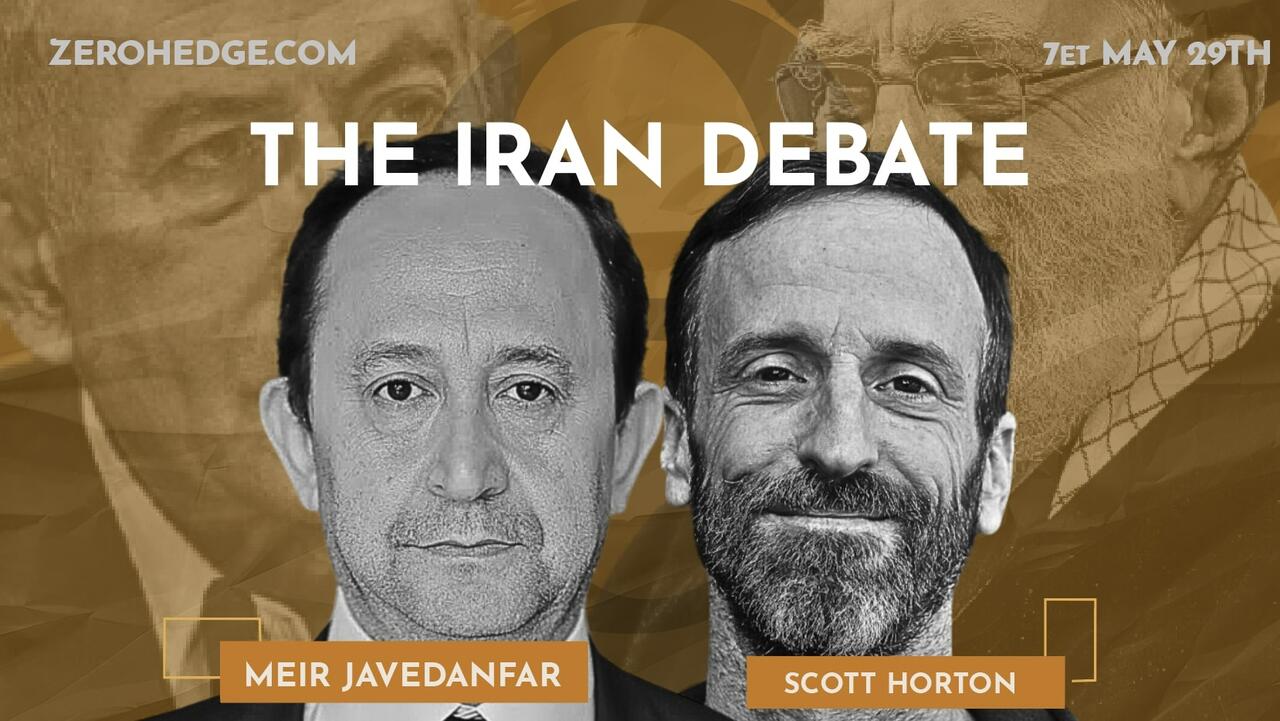 Latest: The Iran Debate
Latest: The Iran Debate